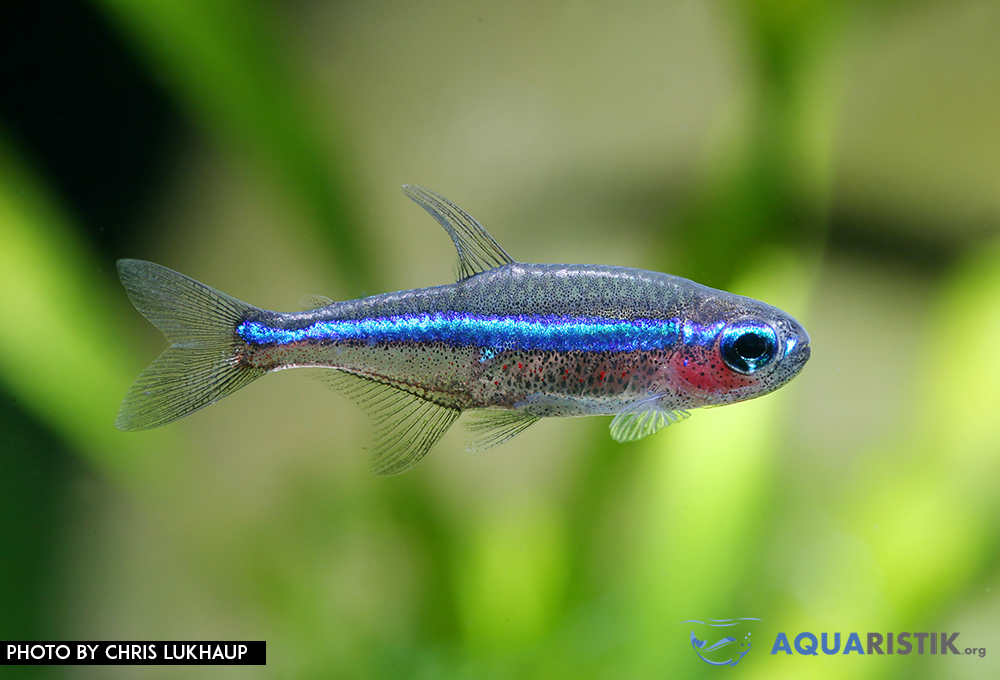Blue Neon: The Blue neons (also called the "Green Neon Tetra") is a very popular freshwater ornamental fish for the aquarium and at the same time easy to care for. The blue neon belongs to the Characidae family, the real collectors. Since it is a shoal fish, it should be kept in the aquarium with conspecifics. The family of true collectors and the order of the Characiformes still include the Red neon, Green neon and the Black neon, but they differ in genus. The other neon species that exist, such as the red neon or the neon tetra, are similar but not closely related to the blue neon. The differences are the number of chromosomes. They are completely separate species. Due to the blue content, it is probably the most beautiful and smallest representative of the subfamily.

In this article you will be given various information about the appearance, breeding, keeping, origin and what water conditions are required. So a fact sheet about them Blue Neons.
Blue neon - origin and distribution of freshwater ornamental fish
Where do the blue neons come from? In tropical South America, in the rivers Orinoco and Rio Negro (Brazil), the blue neon occurs. The Blue neons is the smallest of this subfamily, it has a length of approx. 3 cm to 3,5 cm and can reach a maximum age of 5 years. They usually stay in the middle area of the aquarium. The blue neon is a very peaceful fish.
Appearance and breeding forms of the blue neon
Very good for a community pool is the Blue neons suitable. It is a peaceful fish and does not pose a threat to other fish. However, it can serve as prey for larger fish. Therefore you should pay attention to which fish you associate with the blue neon.
The Blue neons has a fluorescent blue band down the center of the body flank. It runs from the eyes to the caudal peduncle. The area under its head and in the rear area of its abdomen (from the ventral fin) is colored blood red. In the middle of the body flank (above the blue band) it is grayish-brown in color with a silver tinge. Its fins are whitish and transparent. It is usually difficult to distinguish between the females (Rogner) and the males (Milkner). However, the males are a bit slimmer in physique and the females are a bit fuller.
Lifestyle and feeding behavior of the blue neon
When it comes to food, the blue neons are not very demanding. Whether dry food, frozen food (e.g. water fleas), live food, hoppers or even oar crayfish (Cyclops) or brine shrimp (Artemia). The blue neon loves to feed on small insects, such as water fleas, small crabs, etc.
Blue Neon - Posture and Water Conditions
The gregarious blue neon is a schooling fish and feels most at home with its peers and other peaceful fish. At least 15 to 20 of the blue neon should be kept in a swarm with plenty of vegetation in the aquarium and on a dark substrate. The color of the blue neon comes into its own in a blackwater aquarium. What is a blackwater aquarium? A blackwater aquarium is identified by the color of the water. Filtering the water through peat gives the water an amber to brownish color due to the tannins. The red neon and the Glow light collector. The size of the aquarium should be at least 80 liters.
The water is also important. Its habitat is the black water rivers. Turn your aquarium into a blackwater aquarium. How? In which you can use the external or internal filter Active peat pellets fill up. Peat filtering also reduces algae growth. The pH of the water should be less than 7, better 5,5 to 6,0. The total hardness of the water should be approx. 3° dGH to 10° dGH. The water temperature for the Blue neon should be about 23 °C to 27 °C.
The blue neon can im community pool be kept with the following species of fish: mosaic rasbora, red fire dwarf shrimp, red fire catfish, guinea fowl rasbora or for example gourami.
Aquarium planting and breeding of blue neons
The tanks should be planted with fine-leaved plants and be very lush, but ensure enough freedom of movement in the aquarium for swimming, but still have many opportunities to hide. Breeding is very difficult for beginners, but breeding is possible for advanced aquarists.
The Blue Neon is a free spawner. The females of the blue neon lay the eggs between the plants where the sticky eggs get stuck. They usually spawn in pairs. Courtship consists of circling and swimming together as a pair.
Summary of keeping and breeding of Blue Neons:
- the water temperature should be between 23 and 27 °C
- the pH value should be between approx. 5,5 and 7,0
- Aquarium size at least 80 liters
- Schooling fish - keep at least 15 to 20 blue tetras in a school
- Feeding with frozen food, dry food or live food possible
- the blue neon stays in the middle area of the pool
- the blue neon spawns freely on the plants.
- Breeding is only possible for advanced aquarists
- Keeping in the common tank with other fish species possible



